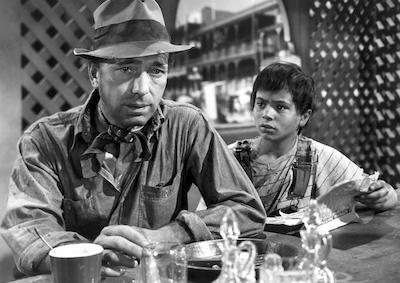The Treasure of the Sierra Madre (1948)
An early indicator of Huston’s postwar penchant for shooting abroad, The Treasure of the Sierra Madre was one of the first Hollywood features to be shot entirely on location out of the country. The Mexico-based production, combined with Huston’s demand for realism, earned him the nickname “Hard-Way Huston” among cast and crew. As Humphrey Bogart explained: “If we could get to a location site without fording a couple of streams and walking through rattlesnake-infested areas in the scorching sun, then it wasn’t quite right.” Huston’s insistence well served his adaptation of B. Traven’s story of desperate prospectors struggling against the elements before succumbing to their own corrupt natures. The New York Times noted that Huston had given the film “the same sort of ruthless realism that was evidenced in his documentaries of war,” while James Agee at Time magazine declared it “one of the best things Hollywood has done since it learned to talk.”
35mm, b/w, 124 min. Production: Warner Bros Pictures Inc. Distribution: Warner Bros Pictures Inc. Directed by John Huston. Producer: Henry Blanke. Based on the novel by B. Traven. Screenwriter: John Huston. Cinematographer: Ted McCord. Editor: Owen Marks. Music: Max Steiner. Cast: Humphrey Bogart, Walter Huston, Tim Holt, Bruce Bennett, Barton MacLane.
The Asphalt Jungle (1950)
With The Maltese Falcon, Huston redefined the possibilities of the detective film. With The Asphalt Jungle, he virtually invented the modern caper film. The influence of Huston’s grungy noir can be felt from Jules Dassin’s Rififi (1955) and Stanley Kubrick’s The Killing (1956) to Bryan Singer’s The Usual Suspects (1995). This was Huston’s third adaptation of a W.R. Burnett novel, having written the scripts for Saint Johnson and High Sierra. At ease with the material, he burrows deeper into the hungers driving his group of characters, a seedy criminal crew that gravitates together for a jewel heist, professionally executes it, and then explodes in a maelstrom of betrayal. Cinematographer Harold Rosson’s hard shadows and claustrophobic framing give the whole film a lit-from-hell vibe. The performances of the film’s ensemble cast, however, including Marilyn Monroe in her feature debut, are what make the whole thing tick. Sterling Hayden’s turn, in particular, as a country-boy-turned-hard-luck-thug expresses the flickering humanity Huston sees in so many of his desperate men. It was a humanity clearly lost on studio head Louis B. Mayer whose expressed distaste for the finished product—“it’s full of nasty, ugly people doing nasty, ugly things”—inadvertently gave Huston’s first film for MGM its best unofficial tagline.
35mm, b/w, 112 min. Production: Metro-Goldwyn-Mayer, Loew’s Inc. Distribution: Metro-Goldwyn-Mayer Corps. Director: John Huston. Producer: Arthur Hornblow. Based on the novel by W.R. Burnett. Screenwriter: Ben Maddow, John Huston. Cinematographer: Harold Rosson. Editor: George Boemler. Music: Miklos Rozsa. Cast: Sterling Hayden, Louis Calhern, Jean Hagen, James Whitmore, Sam Jaffe.






 Mobile Navigation
Mobile Navigation

